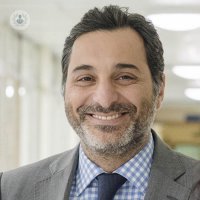What is minimally-invasive aortic valve replacement surgery?
Written in association with:A healthy aortic valve opens wide to allow blood to exit the heart into the aorta and closes tightly to prevent blood from flowing back into the heart. Aortic valve disease occurs when the valve is unable to open or close properly. Aortic stenosis is a narrowing of the aortic valve that prevents the valve from opening properly, holding back the flow of blood from the heart's left chamber into the aorta. Aortic regurgitation occurs when the aortic valve does not close properly between heartbeats, allowing blood to regurgitate, or spill back, from the aorta into the left ventricle.
Mr Toufan Bahrami, a top cardiothoracic surgeon and a leader in the field of minimally-invasive aortic valve replacement surgery, explains why the aortic valve malfunctions and how surgery can overcome this problem.
What is the reason for aortic valve replacement surgery?
Aortic valve replacement is the most effective method of treating severe aortic valve disease. The aortic valve may need to be replaced for the following reasons:
- The valve has become narrowed (aortic stenosis).
- The opening of the valve has become smaller, obstructing the flow of blood out of the heart.
- The valve is leaky and allows blood to flow back into the heart.
The problems can get worse over time and in severe cases can lead to life-threatening problems such as heart failure, if left untreated. There are no medicines to treat aortic valve problems, so replacing the valve will be recommended if the patient is at risk of serious complications, but are otherwise well enough to have surgery.
What are the symptoms?
Some people with aortic valve disease may not experience symptoms for many years. Signs and symptoms of aortic valve disease may include:
- Abnormal heart sound (heart murmur) heard through a stethoscope
- Shortness of breath, particularly when they have been very active or when they lie down
- Dizziness
- Fainting
- Chest pain or tightness
- Irregular heartbeat
- Fatigue after being active or having less ability to be active
- Swelling of the ankles and feet
What is the procedure for minimally invasive aortic sutureless valve replacement surgery?
The most common minimally invasive techniques are ministernotomy and right anterior minithoracotomy approaches. The minimally invasive techniques for aortic valve replacement can be performed through a small incision either on the side of the chest (muscles in the area will be divided) or only through the upper part of the sternum as opposed to a conventional full sternotomy. This allows the surgeon to reach the heart and aortic valve.
These techniques have proved to be a safe approach for the treatment of aortic valve disease and are associated with a number of additional benefits for patients. These approaches are increasingly being used with the aim of reducing the “invasiveness” of the surgical procedure, while maintaining the same efficacy, quality and safety of a conventional approach. Despite these advantages, this procedure is limited by the longer cardiopulmonary bypass time, which has raised some concerns in fragile and high risk patients. However, with the introduction of sutureless and fast deployment valves, operative times have dramatically reduced by 35-40%, standardising this procedure.
What are the benefits of this procedure?
Advantages of minimally invasive approaches include:
- Reduced number of complications, such as wound infection.
- Smaller incisions and improved aesthetic appearance of scars which also facilitate reoperation at a later date as part of the pericardium remains closed.
- Reduced length of hospital stay and a faster recovery
- Less pain
- Reduced need for blood transfusion
If you are concerned about your heart's health, make an appointment with a specialist.



